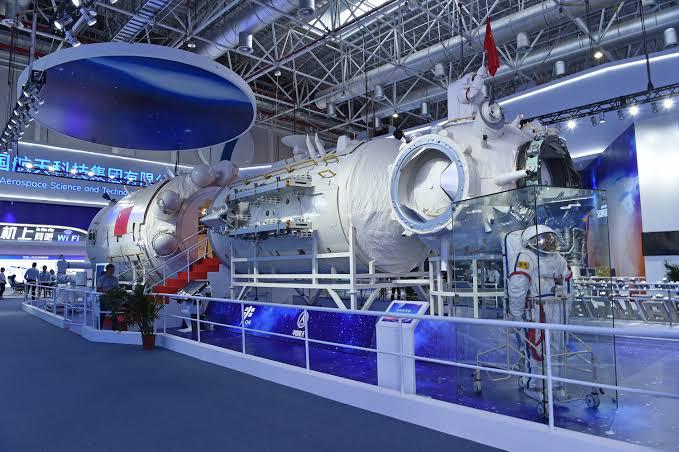China is carrying out multiple engineering experiments in its space station, located in a near-Earth orbit, to acquire know-how that can support more experimental possibilities and human survival in outer space. The Space Basic Experiment Cabinet, mounted on the country’s space lab module Mengtian, is carrying its first group of five experiments on space technology. The experiments aim to figure out how to resist microbes that may eat away spacecraft metals, produce oxygen from algae in space, and convert heat energy into electricity.
One of the drawers installed onto the cabinet is the microbial resistance facility, as microbes tend to have a significant corrosive influence on materials in a confined space module, making effective in-orbit management of them crucial for any long-term space presence. The facility, projected to complete the first high-throughput microbial resistance experiment in the world, is a detachable box in which microbial growth will be actively controlled in microgravity before implementing PCR testing and subsequent quarantine and disinfection. The first microbe being tested is fungus Aspergillus niger, a type of mildew that may corrode the copper and aluminum alloy.
The box will be used as a key biological safety platform for scientific research and technical identification in the space station, according to the China Academy of Space Technology (CAST). The biological chemistry in space can also be utilized to produce fundamental elements for human survival. An algae cultivation test in the cabinet is designed to examine how efficiently the water plant can generate oxygen and how to cook it on site.
Microalgae is a primary producer on Earth that makes the planet oxygen-rich, and it is believed to be highly tolerant to zero-gravity and cosmic radiation. Some kinds of it are capable of synthesizing protein, fatty acid, and sugar-like nutrients to offer safe food supplements for astronauts. In Mengtian, the algae will be cultivated in both solid and liquid culture, and then the liquid-supported algae will be heated in a “microwave oven.” This is a significant attempt that may lay a foundation for extended space travel and long-term human habitation in the future, said the CAST.
These experiments are vital to ensuring human survival in outer space and expanding scientific knowledge of space technology. The findings may be used to develop more effective strategies for handling microbes and other biological elements that may pose a threat to space missions. The successful cultivation of algae in space may also lead to new possibilities for sustainable living and food production in space. The experiments conducted in the Space Basic Experiment Cabinet are paving the way for new space technology that can support future missions and scientific discoveries.
Another drawer in the cabinet is dedicated to the Stirling thermoelectric converter, which is a pilot engine that can convert thermal energy to electricity with relatively high efficiency and power density. Two pistons in a cylinder moving at high frequency drive the heat-to-electricity conversion tech. Engineers are testing the feasibility and stability of the technology in orbit to provide clues for developing advanced power technology in space, which can be used in future deep-space exploration.
In another experiment, material scientists are testing how to utilize liquid metal in space. Gallium-based and bismuth-based metals are alloys that can flow at normal temperatures or slightly higher. They have several desirable properties, including good conductivity, high boiling points, and good heat transmission capacity. The experiment will verify the liquid metal’s performance in rapid melting, electromagnetic drive, sealing, and inflation protection, which may help develop emerging and disruptive technologies.
A third experiment aims to evaluate the hazards of chippings produced by a device based on friction between electric brushes and slip rings. The device is used for power and signal transfer in the solar array drive assembly and spacecraft altitude control gyroscope. The test will take pictures of the real motions of rubbing fragments to lay a foundation for an optimized device that can ensure long-duration operation of spacecraft.
Microbes tend to have a significant corrosive influence on materials in a confined space module, which makes effective in-orbit management crucial for any long-term space presence. Therefore, the cabinet has a microbial resistance facility. A detachable box in the facility is projected to complete the first high-throughput microbial resistance experiment in the world. The facility actively controls microbial growth in microgravity before implementing PCR testing and subsequent quarantine and disinfection. The first microbe being tested is the fungus Aspergillus niger, a type of mildew that may corrode copper andaluminum alloy.
Finally, an algae cultivation test in the cabinet is examining how efficiently the water plant can generate oxygen and how to cook it on site. Microalgae is a primary producer on Earth that makes the planet oxygen-rich and is believed to be highly tolerant to zero-gravity and cosmic radiation. Some kinds of microalgae are capable of synthesizing protein, fatty acid, and sugar-like nutrients to offer safe food supplements for astronauts. The algae will be cultivated in both solid and liquid culture, and then the liquid-supported algae will be heated in a “microwave oven.” This significant attempt may lay a foundation for extended space travel and long-term human habitation in the future.
